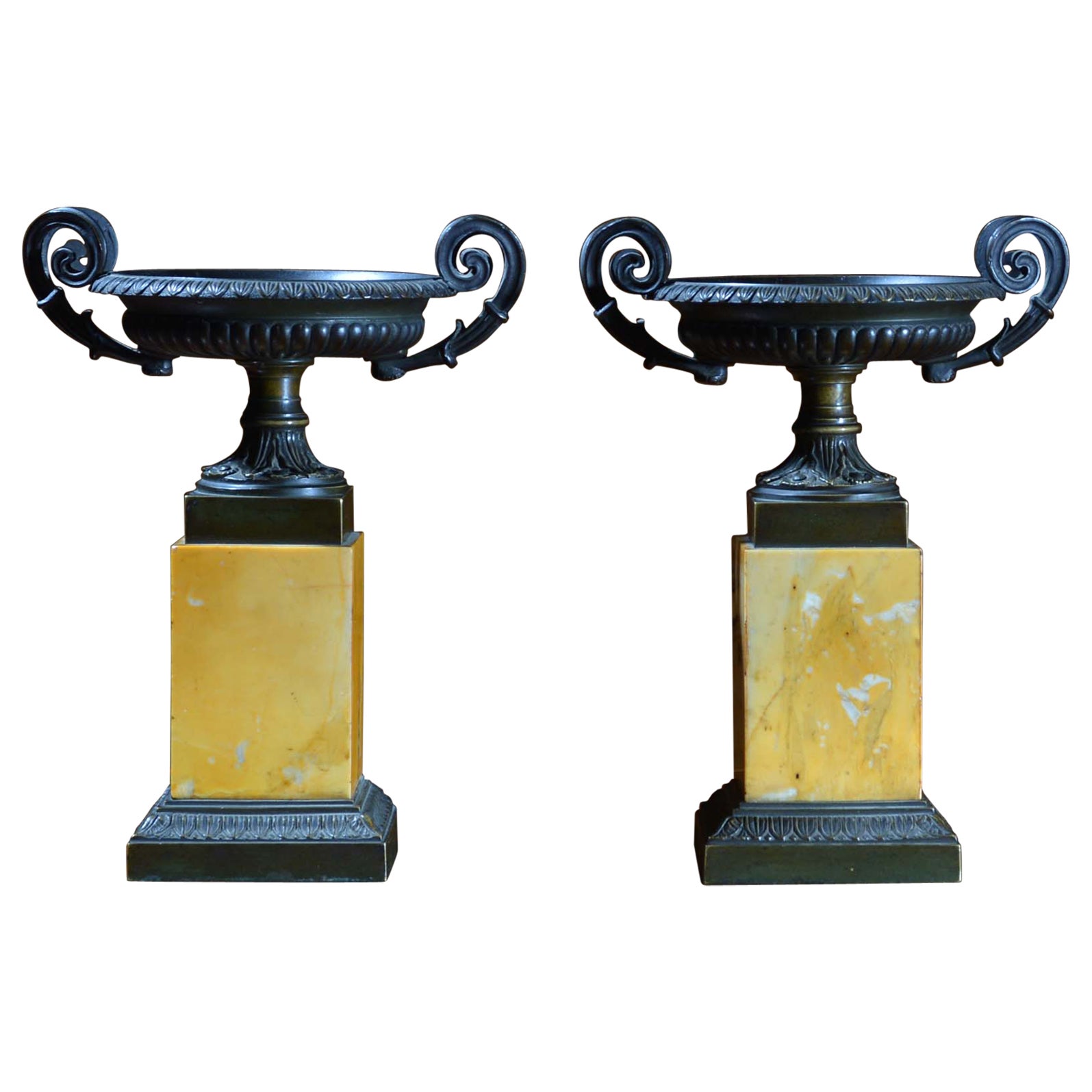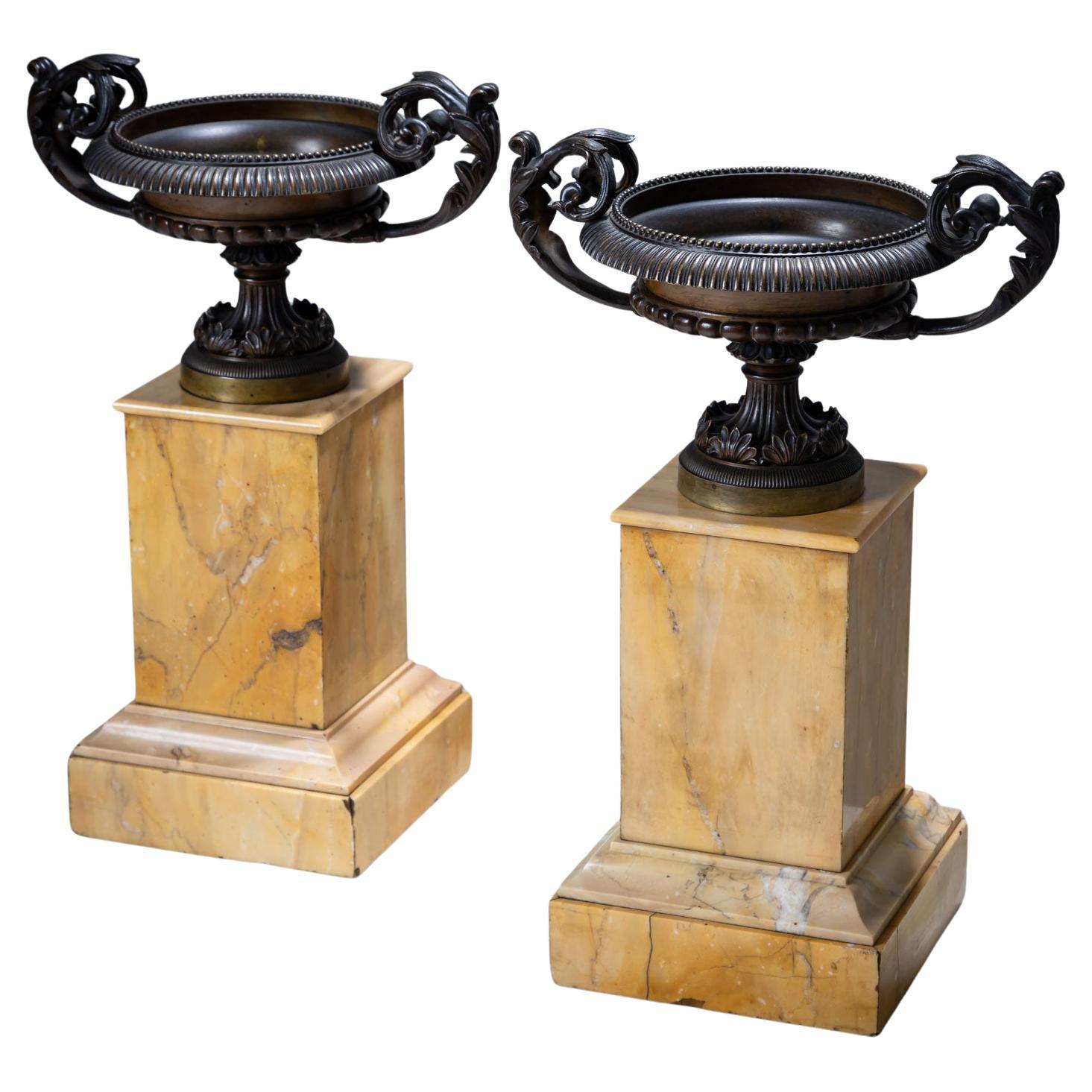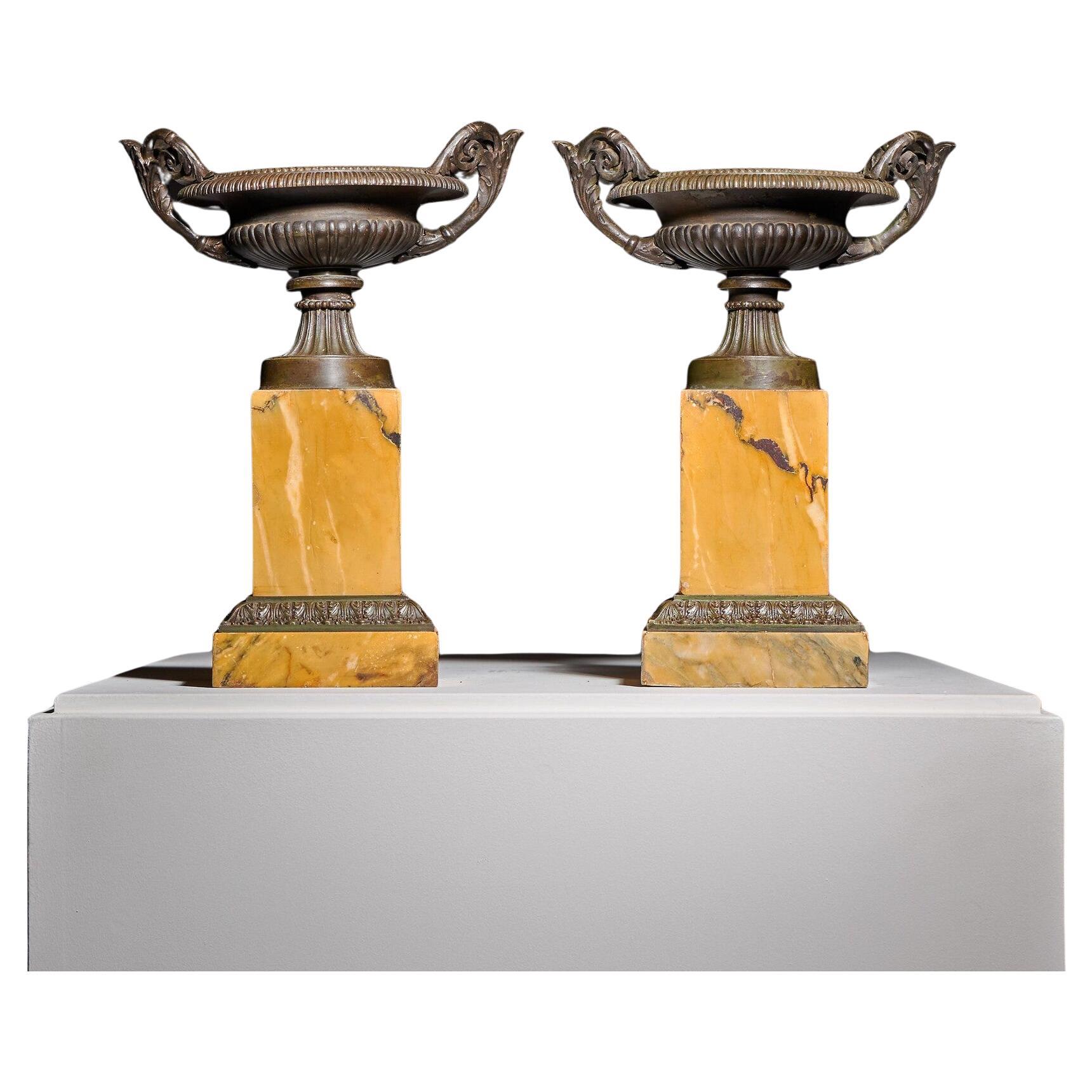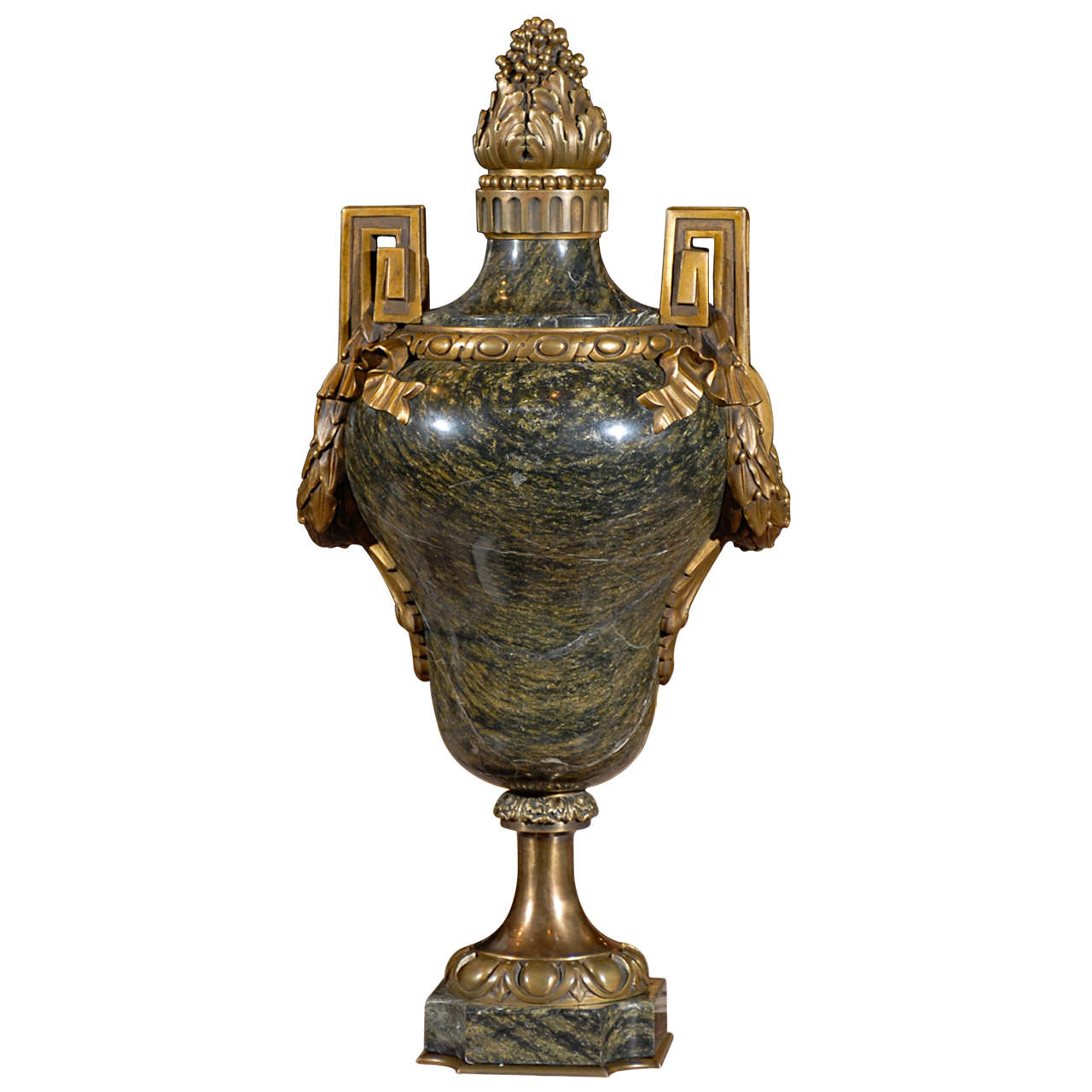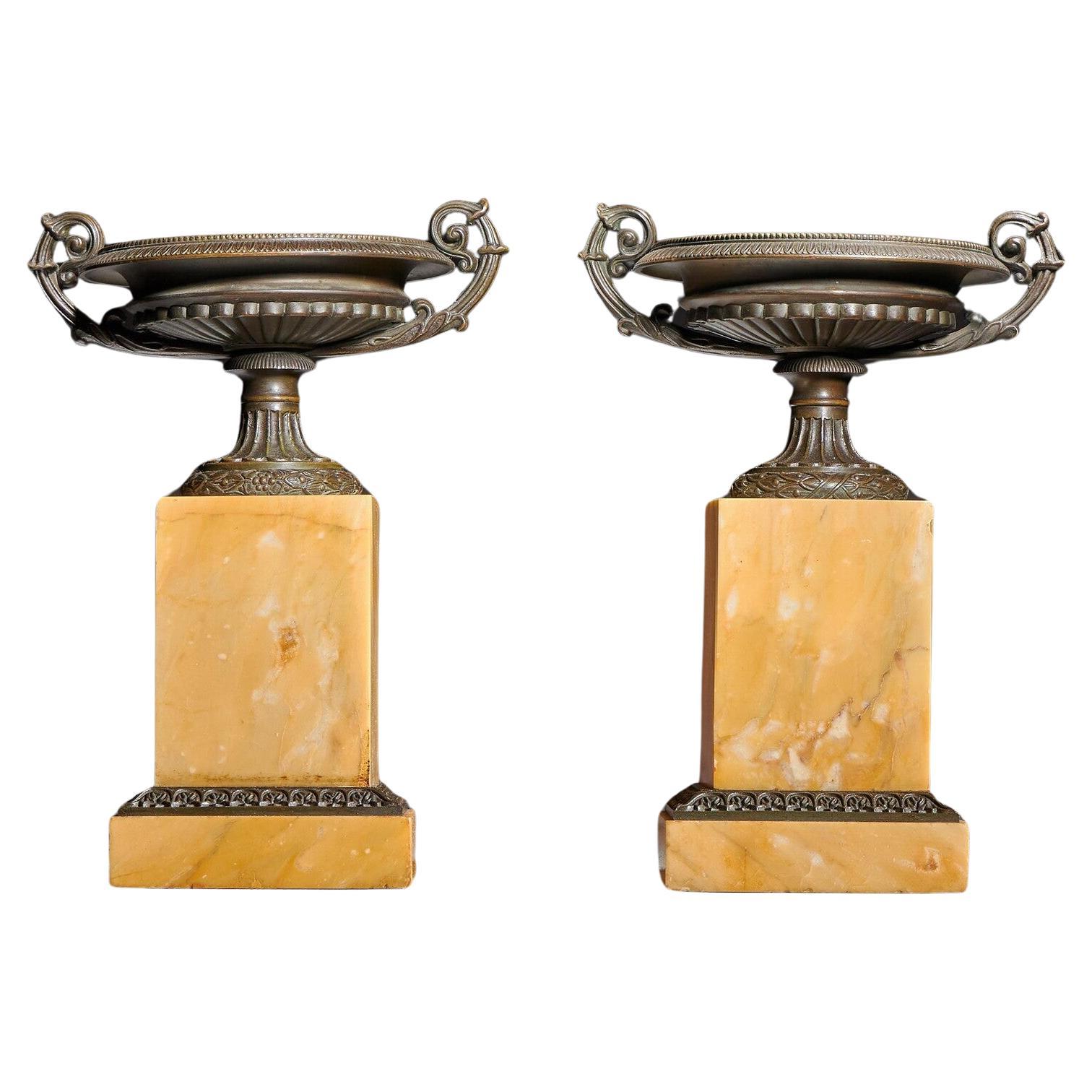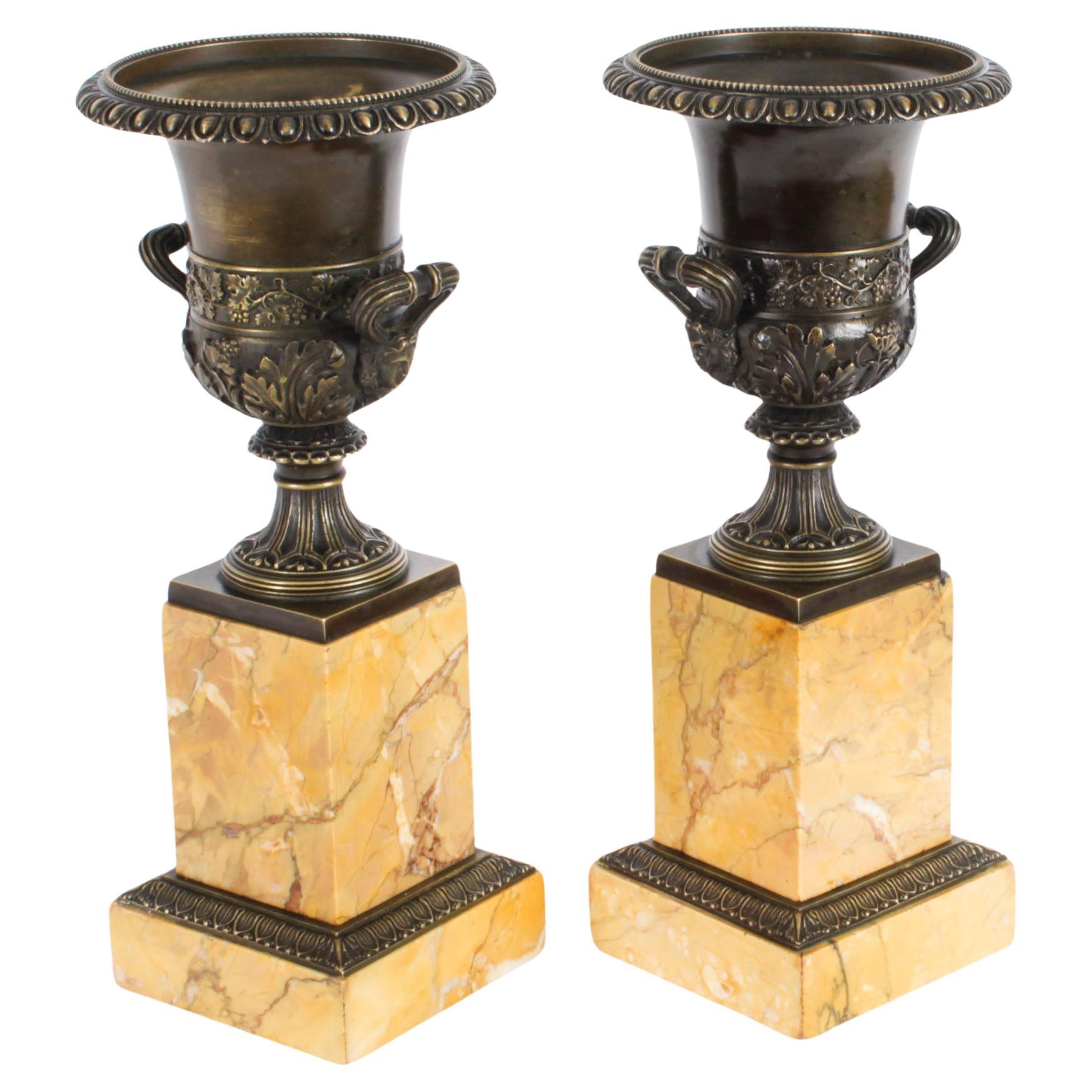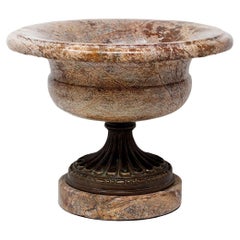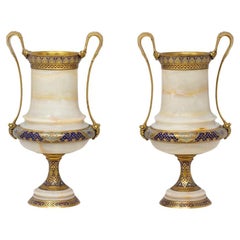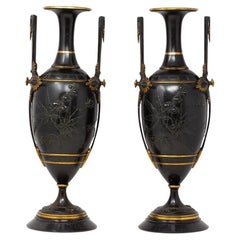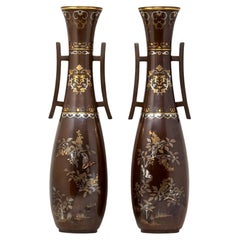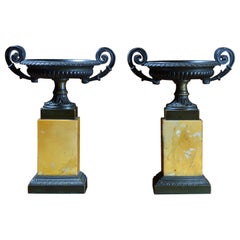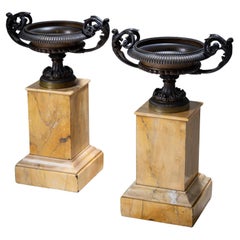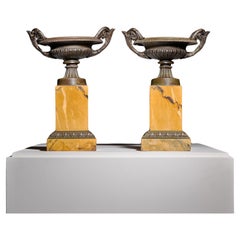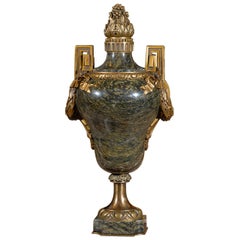Objekte ähnlich wie French Antique Siena Marble and Bronze Tazza Urns
Möchten Sie mehr Bilder oder Videos?
Zusätzliche Bilder oder Videos von dem*der Anbieter*in anfordern
1 von 13
French Antique Siena Marble and Bronze Tazza Urns
Angaben zum Objekt
Applied Lyre Decoration
From our Decorative collection, we are delighted to offer this pair of fabulous French Siena Marble Tazza Urns. The pair of Tazza Urns stood upon four cast Bronze feet with a pedestal Siena Marble foot with an applied bronze scrollwork border. The central square column with a bronze Swan neck lyre harp bordered by floral swags to the front of the vase. The base of each Tazza Urn cast in Bronze with Ram’s head twin loop handles and a floral band surmounted by a tapered Siena Marble Core finished with a Bronze liner. The Tazza Urns dating to the first half of the 19th century during the latter reign of Charles X circa 1830.
Bronze an alloy consisting primarily of copper with approximately 12–12.5% tin and often with the addition of other metals (including aluminium, manganese, nickel, or zinc) and sometimes non-metals, such as phosphorus, or metalloids such as arsenic or silicon depending on the age of the bronze and its origin. The additions of other metals produce a range of alloys that are usually harder than copper alone and carry useful properties such as strength. The earliest known use of bronze dates to the 5th millennium BCE from Iranian plateau, the bronze mix consists of arsenical copper and copper-arsenide. The earliest tin-copper-alloy recovered is dated to circa 4650 BCE and was found in Plocnik, Serbia. It is believed to have been smelted from a natural tin-copper ore.
Sienna Marble consists of various dark yellow and gold colours, it is extremely heterogeneous due to the presence of grains with shades ranging from ivory white to light yellow to a reddish yellow ocher and is usually an intense marble.
Lyre a stringed musical instrument part of the lute-family and consists of two arms and a crossbar with strings. The Lyre has featured on classical objects like the pair of vases above for thousands of years. They were commonly used in several ancient cultures surrounding the Mediterranean Sea. The earliest known examples of the lyre have been recovered at archaeological sites that date to c. 2700 BCE in Mesopotamia.
Charles X (Charles Philippe 1757-1836) was the King of France during a short reign between 1824 to 1830. He was the uncle of the uncrowned Louis XVII and younger brother to reigning kings Louis XVI and Louis XVIII, he supported the latter in exile. After the Bourbon Restoration in 1814, Charles (as heir-presumptive) became the leader of the ultra-royalists which was a radical monarchist faction within the French court. The ultra-royalists declared absolute monarchy by divine right and opposed the constitutional monarchy concessions towards liberals and the guarantees of civil liberties granted by the Charter of 1814. Charles gained influence after the shocking assassination of his son Charles Ferdinand, Duke of Berry, in 1820. Charles went on to succeed his brother Louis XVIII in 1824 to become the King of France.
His reign of almost six years proved to be deeply unpopular amongst the liberals in France from the moment of his coronation in 1825, in which he tried to revive the practice of the royal touch. Throughout his short lived reign Charles remained unpopular and tried various methods to deter the spotlight such as the conquest of Algeria and forcing Haiti to pay a hefty indemnity in return for lifting a blockade and recognising Haiti’s independence. Eventually the Charles was abdicated, and Louis Philippe I became the King of the French. Charles was exiled and died in 1836 in Gorizia, then part of the Austrian Empire. He was the last of the French rulers from the senior branch of the House of Bourbon.
- Maße:Höhe: 46 cm (18,12 in)Durchmesser: 20 cm (7,88 in)
- Stil:Charles X. (Aus dem Zeitalter)
- Materialien und Methoden:
- Herkunftsort:
- Zeitalter:
- Herstellungsjahr:Circa 1830
- Zustand:Abnutzung dem Alter und der Nutzung entsprechend. Geringfügige Schäden. Excellent, untouched condition, very minor nibbles to the marble extremities.
- Anbieterstandort:Newark, GB
- Referenznummer:Anbieter*in: BRDD1stDibs: LU6971245210842
Anbieterinformationen
5,0
Geprüfte*r Anbieter*in
Jede*r Anbieter*in erfüllt strenge Standards bezüglich Echtheit und Zuverlässigkeit
Gründungsjahr 2019
1stDibs-Anbieter*in seit 2022
33 Verkäufe auf 1stDibs
Typische Antwortzeit: 1 Stunde
- VersandAngebot wird abgerufen …Versand von: Newark, Vereinigtes Königreich
- Rückgabebedingungen
Einige Inhalte dieser Seite wurden automatisch übersetzt. Daher kann 1stDibs nicht die Richtigkeit der Übersetzungen garantieren. Englisch ist die Standardsprache dieser Website.
Authentizitätsgarantie
Im unwahrscheinlichen Fall eines Problems mit der Echtheit eines Objekts kontaktieren Sie uns bitte innerhalb von 1 Jahr für eine volle Rückerstattung. DetailsGeld-Zurück-Garantie
Wenn Ihr Objekt nicht der Beschreibung entspricht, beim Transport beschädigt wurde oder nicht ankommt, kontaktieren Sie uns bitte innerhalb von 7 Tagen für eine vollständige Rückerstattung. DetailsStornierung innerhalb von 24 Stunden
Sie können Ihren Kauf jederzeit innerhalb von 24 Stunden stornieren, ohne jegliche Gründe dafür angeben zu müssen.Geprüfte Anbieter*innen
Unsere Anbieter*innen unterliegen strengen Dienstleistungs- und Qualitätsstandards, wodurch wir die Seriosität unserer Angebote gewährleisten können.Preisgarantie
Wenn Sie feststellen, dass ein*e Anbieter*in dasselbe Objekt anderswo zu einem niedrigeren Preis anbietet, werden wir den Preis entsprechend anpassen.Zuverlässige weltweite Lieferung
Unsere erstklassigen Versandunternehmen bieten spezielle Versandoptionen weltweit, einschließlich individueller Lieferung.Mehr von diesem*dieser Anbieter*in
Alle anzeigenGrand Tour Marmor und Bronze Tazza Urnenaufsatz
Vorbau aus Bronzeguss
Aus unserer dekorativen Kollektion bieten wir Ihnen diese Grand Tour Sarrancolin Tazza Urne aus Marmor an. Die Grand Tour Tazza Urne von typischer Form aus Sar...
Kategorie
Antik, Spätes 19. Jahrhundert, Französisch, Grand Tour, Tafelaufsätze
Materialien
Marmor, Bronze
Französische Champleve- und Onyx-Urnen Barbedienne
Von Ferdinand Barbedienne
Onyx & Champleve-Emaille
Wir freuen uns, Ihnen aus unserer dekorativen Kollektion dieses Paar französischer Urnen aus Champleve und Onyx anbieten zu können, die Barbedienne zugesch...
Kategorie
Antik, Spätes 19. Jahrhundert, Französisch, Belle Époque, Urnen
Materialien
Onyx, Bronze, Emaille, Goldbronze
Französische Bronzevasen des Aesthetic Movement
Von Ferdinand Barbedienne
Dekoriert mit Insekten
Aus unserer dekorativen Kollektion bieten wir Ihnen ein Paar Bronzevasen der französischen Ästhetischen Bewegung an. Die Vasen aus französischer Bronze stehen...
Kategorie
Antik, Spätes 19. Jahrhundert, Französisch, Ästhetizismus, Vasen
Materialien
Schiefer, Bronze, Goldbronze
Japanese Pair of Large Antique Meiji Period Bronze and Mixed Metal Vases
Inlaid with Gold and Silver
From our Japanese collection, we are thrilled to offer a Japanese Pair of Meiji Period Bronze Vases. The Japanese Bronze Vases of elongated form each sur...
Kategorie
Antik, Spätes 19. Jahrhundert, Japanisch, Meiji-Periode, Vasen
Materialien
Metall, Gold, Silber, Bronze
Antike French Opaline Ormolu montierte Violettglasvasen
BELLE EPOQUE UM 1890
Wir freuen uns, Ihnen aus unserer Glassware-Kollektion dieses schöne Paar antiker französischer Opalglasvasen anbieten zu können. Die antiken französischen Vase...
Kategorie
Antik, Spätes 19. Jahrhundert, Französisch, Belle Époque, Vasen
Materialien
Bronze, Goldbronze
Antikes französisches Paar Limoges-Emaille-Vasen
Von Limoges
Belle Epoque CIRCA 1880
Wir freuen uns, Ihnen dieses Paar antiker französischer Limoges-Emaille-Vasen aus unserer dekorativen Kollektion anbieten zu können. Französische Vasen aus L...
Kategorie
Antik, Spätes 19. Jahrhundert, Französisch, Belle Époque, Vasen
Materialien
Metall, Emaille
Das könnte Ihnen auch gefallen
Paar Grand Tour Bronze- und Siena-Marmor-Tazza-Tazzas aus Bronze
Ein Paar Tazza aus Bronze und Marmor aus Siena von Grand Tour
Diese wohlgeformten, niedrigen Urnen mit kannelierter Schale und geformtem Fuß, jeweils mit zwei Henkelpaaren, stehen au...
Kategorie
Antik, Frühes 19. Jahrhundert, Französisch, Grand Tour, Urnen
Materialien
Siena-Marmor, Bronze
Paar Bronze-Tazzas auf Siena-Marmorsockeln
Ein Paar Bronze-Tazzas im neoklassischen Stil, aufwendig gearbeitet und auf quadratischen Sockeln aus exquisitem Siena-Marmor montiert. Die Kombination aus Bronze und Marmor verleiht...
Kategorie
Antik, 19. Jahrhundert, Deutsch, Neoklassisch, Vasen
Materialien
Siena-Marmor, Bronze
3.241 $ / Set
Großes Paar französischer Grand Tour-Tazza-Bronze und Siena-Marmor aus dem frühen 19. Jahrhundert
Ein feines und dekoratives Paar französischer Grand-Tour-Bronze- und Siena-Marmor-Tazzas von großem Format
Französisch um 1820
Diese feinen Tazzas weisen eine beeindruckende Patini...
Kategorie
Antik, 1820er, Französisch, Urnen
Materialien
Marmor, Bronze
Antike Urne aus Bronze und Marmor
Prächtige Urne aus Bronze und Marmor
Kategorie
Antik, 19. Jahrhundert, Französisch, Vasen und Gefäße
Materialien
Marmor, Goldbronze
Ein feines Paar französischer Grand Tour-Tazzas aus Bronze und Siena-Marmor aus dem frühen 19. Jahrhundert
Ein feines Paar französischer Grand-Tour-Bronze- und Siena-Marmor-Tazas des frühen 19. Jahrhunderts mit interessantem Design
Französisch CIRCA 1830
Diese schönen Tazzas stehen auf...
Kategorie
Antik, 1830er, Französisch, Urnen
Materialien
Siena-Marmor, Bronze
Antikes Paar Grand Tour Borghese-Urnen aus Bronze und Siena-Marmor Campana, 19. Jahrhundert
Ein prächtiges Paar antiker Urnen aus Bronze und Siena-Marmor der Borghese Campana aus der Zeit um 1870.
Dieses Paar von patinierten Die Campana-Urnen aus Bronze sind nach den Mode...
Kategorie
Antik, 1870er, Grand Tour, Urnen
Materialien
Marmor, Bronze
